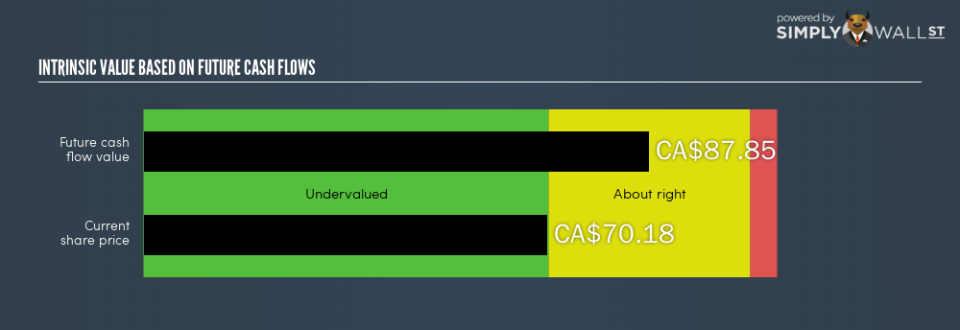The Bank of Nova Scotia (TSE:BNS) Is Trading At A 20.11% Discount Right Now

Bank stocks such as BNS are hard to value. This is because the rules banks face are different to other companies, which can impact the way we forecast their cash flows. For instance, banks must hold a certain level of cash reserves on the books as a safety precaution. Focusing on elements like book values, as well as the return and cost of equity, is suitable for evaluating BNS’s true value. Below we will look at how to value BNS in a relatively useful and easy approach.
Check out our latest analysis for Bank of Nova Scotia
What Is The Excess Return Model?
Two main things that set financial stocks apart from the rest are regulation and asset composition. Canada’s financial regulatory environment is relatively strict. In addition, banks generally don’t have substantial portions of tangible assets as part of total assets. As traditional valuation models put weight on inputs such as capex and depreciation, which is less meaningful for finacial firms, the Excess Return model places importance on forecasting stable earnings and book values.
Calculating BNS’s Value
The central assumption for this model is, the value of the company is how much money it can generate from its current level of equity capital, in excess of the cost of that capital. The returns in excess of cost of equity is called excess returns:
Excess Return Per Share = (Stable Return On Equity – Cost Of Equity) (Book Value Of Equity Per Share)
= (0.14% – 9.9%) x CA$56.22 = CA$2.41
Excess Return Per Share is used to calculate the terminal value of BNS, which is how much the business is expected to continue to generate over the upcoming years, in perpetuity. This is a common component of discounted cash flow models:
Terminal Value Per Share = Excess Return Per Share / (Cost of Equity – Expected Growth Rate)
= CA$2.41 / (9.9% – 2.3%) = CA$31.62
Combining these components gives us BNS’s intrinsic value per share:
Value Per Share = Book Value of Equity Per Share + Terminal Value Per Share
= CA$56.22 + CA$31.62 = CA$87.85
This results in an intrinsic value of CA$87.85. Relative to the present share price of CA$70.18, BNS is , at this time, priced below its intrinsic value. This means BNS can be bought today at a discount. Valuation is only one side of the coin when you’re looking to invest, or sell, BNS. Fundamental factors are key to determining if BNS fits with the rest of your portfolio holdings.
Next Steps:
For banks, there are three key aspects you should look at:
Financial health: Does it have a healthy balance sheet? Take a look at our free bank analysis with six simple checks on things like bad loans and customer deposits.
Future earnings: What does the market think of BNS going forward? Our analyst growth expectation chart helps visualize BNS’s growth potential over the upcoming years.
Dividends: Most people buy financial stocks for their healthy and stable dividends. Check out whether BNS is a dividend Rockstar with our historical and future dividend analysis.
For more details and sources, take a look at our full calculation on BNS here.
To help readers see past the short term volatility of the financial market, we aim to bring you a long-term focused research analysis purely driven by fundamental data. Note that our analysis does not factor in the latest price-sensitive company announcements.
The author is an independent contributor and at the time of publication had no position in the stocks mentioned. For errors that warrant correction please contact the editor at editorial-team@simplywallst.com.

 Yahoo Finance
Yahoo Finance 
